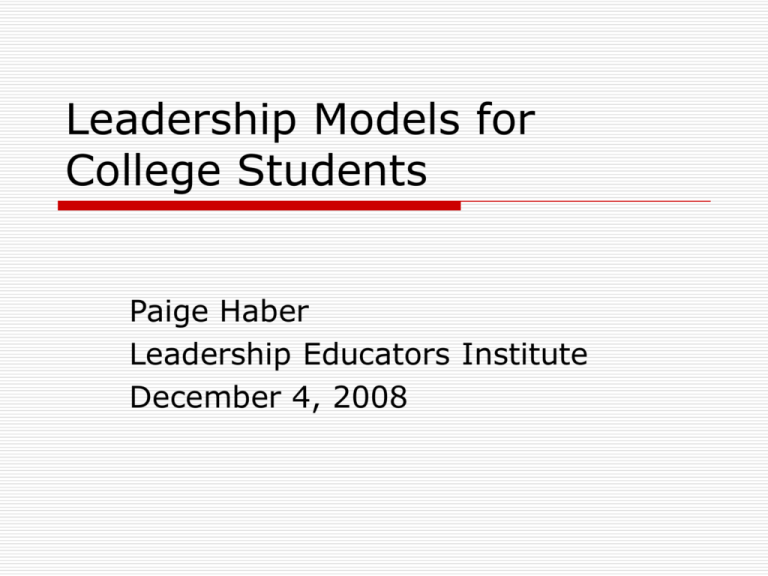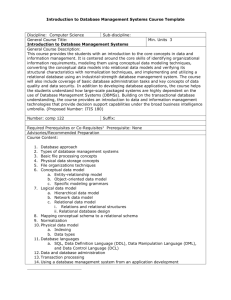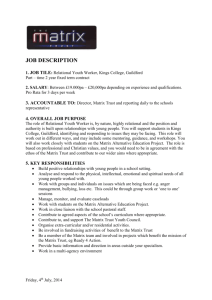Leadership Models for College Students
advertisement

Leadership Models for College Students Paige Haber Leadership Educators Institute December 4, 2008 Overview of Presentation 5 Exemplary Practices of Leadership Relational Leadership Model Social Change Model of Leadership Servant Leadership Leadership Identity Development Emotionally Intelligent Leadership 5 Exemplary Practices of Leadership Kouzes and Posner The Leadership Challenge (4th Ed. 2008); The Student Leadership Challenge (2008) Leadership Practices Inventory (LPI); Student Leadership Practices Inventory (SLPI) Research on thousands of leaders in different contexts 5 Exemplary Practices of Leadership When getting extraordinary things done in organizations, leaders: Model the Way Inspire a Shared Vision Challenge the Process Enable Others to Act Encourage the Heart Relational Leadership Model (RLM) Komives, Lucas & McMahon, 1998, 2006 From Exploring Leadership: For College Students Who Want to Make a Difference Aspirational model for supporting a healthy, ethical, and effective group Purpose of the model is vision-driven (not position-driven) Leadership is a relational and ethical process of people together attempting to accomplish positive change. Relational Leadership Model Knowing, Being, Doing Purposeful & Inclusive Purposeful Committed to a goal or activity Finding common purpose with others Being aware of the vision helps make sure your activities are in line with what your ultimate purpose is Working toward positive change Inclusive Understanding, valuing, and actively engaging diversity in: Views Approaches or Styles Aspects of individuality Developing the strengths and talents of the group members so they can help work toward group goals Empowering & Ethical Empowering 2 dimensions: Sense of self that expects to be involved and claims ownership and a place in the process Set of environmental conditions that promote the full involvement of participants by reducing barriers Involves sharing power Ethical Leadership driven by values and standards Most people expect leaders to do the right thing Involves leadership for a higher purpose than just self Leadership is good and moral by nature Process How a group goes about being a group, remaining a group, and accomplishing a group’s purpose Recruitment & involvement of group members, how a group makes decision, how it handles tasks, how it handles conflict Process is intentional (not accidental) “How” is just as important as the “what” Social Change Model of Leadership (SCM) Higher Education Research Institute, 1996 Ensemble of leadership scholars developed SCM SCM Book Coming out Soon- Wagner & Komives Socially Responsible Leadership Scale (SRLS) (Tyree, 1998) Framework for Multi-Institutional Study of Leadership (MSL) Social Change Model of Leadership- Basic Premise Inclusive- of people in positional and non-positional roles Leadership is a process (not a position) Promotes values of: equity, social justice, self-knowledge, service, collaboration The Model Individual Values Consciousness of self: being self-aware of the beliefs, values, attitudes and emotions that motivate you to take action. Congruence: Acting in ways that are consistent your values and beliefs. Commitment: Having significant investment in an idea or person, both in terms of intensity and duration. Group Values Collaboration: Working with others in a common effort, sharing responsibility, authority, and accountability. Common Purpose: Having shared aims and values. Involving others in building a group’s vision and purpose. Controversy with Civility: Recognizing 2 fundamental realities of any creative effort: 1) differences in viewpoint are inevitable, and 2) such differences must be aired openly but with civility. Community Value Citizenship: Believing in a process whereby an individual and/or group become responsibly connected to the community and to society through some activity. Recognizing individuals and groups have responsibility for the welfare of others. Overall Goal of the Model Change: Believing in the importance of making a better world and a better society for oneself and others. Believing that individuals, groups, and communities have the ability to work together to make that change. Servant Leadership Greenleaf, 1977 “natural feeling that one wants to serve, to serve first. Then the conscious choice brings one to aspire to lead” (p. 23) commitment to serve others or a cause rather than serving oneself (put people and organizations before themselves) A Servant Leader… 1. 2. 3. 4. Listens intently and receptively Exercises empathy Nurtures healing and wholeness Unflinchingly and consistently applies ethics and values 5. Builds cooperation within the team through persuasion 6. "Dreams big dreams" - Conceptualization 7. Exercises foresight 8. Understands service and stewardship as the first and foremost priority 9. Nurtures the growth of employees 10. Builds community within the organization Emotionally Intelligent Leadership (EIL) Shankman & Allen, 2008 From Emotionally Intelligent Leadership: A Guide for College Students Leadership involves 3 areas of consciousness: Context Self Others Emotionally Intelligent Leadership Consciousness Consciousness Consciousness of Context of Self of Others Environmental awareness Emotional self-perception Empathy Group savvy Honest self-understanding Citizenship Healthy self-esteem Inspiration Emotional self-control Influence Authenticity Coaching Flexibility Change agent Achievement Conflict management Optimism Developing relationships Initiative Teamwork Capitalizing on differences Leadership Identity Development (LID) Komives et al., 2005 Process by which one develops a leadership identity Relational view of leadership Grounded theory study of college students who were viewed as strong student leaders who demonstrate relational leadership 6 LID Stages 1. 2. 3. 4. 5. 6. Awareness Exploration/ Engagement Leader Identified Leadership Differentiated Generativity Integration/ Synthesis Dependence 1. Awareness “Other people are leaders; Leadership exists somewhere.” 2. Exploration/ Engagement “I want to be involved” Independence 3. Leader Identified “A leader gets things done; I am the leader and others follow me” **Transition** Interdependence 4. Leadership Differentiated • “I can be a leader even if I’m not the leader; We are all doing leadership together.” 5. Generativity • “I am responsible to my communities and the future of them; I am responsible for developing the leadership of others.” 6. Integration/ Synthesis • “I know I am able to work effectively with others to accomplish changes from anywhere in the organization” Leadership Models for College Students Paige Haber Leadership Educators Institute December 4, 2008




